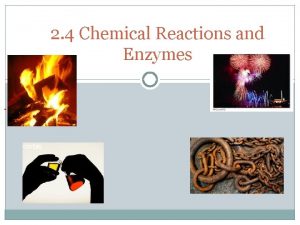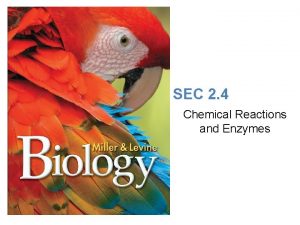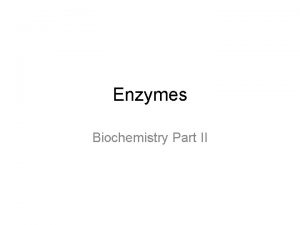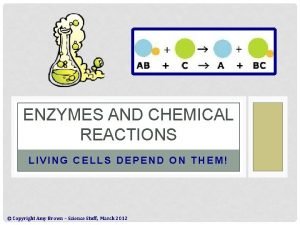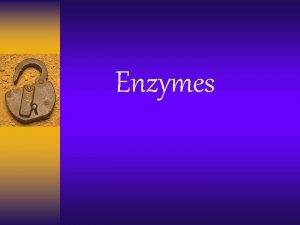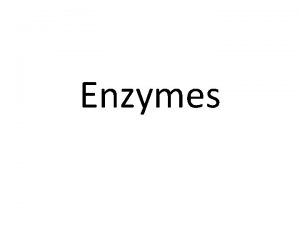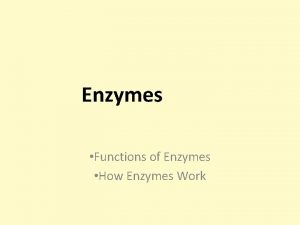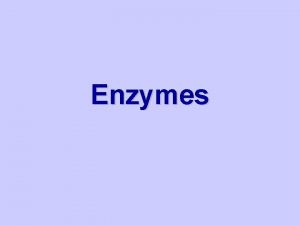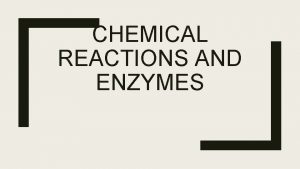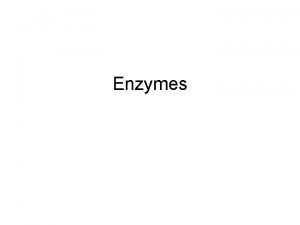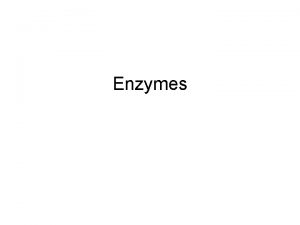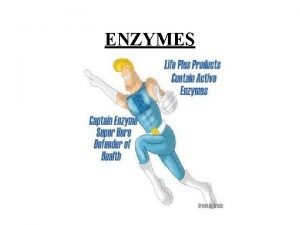Chemical Reactions and Enzymes Chapter 2 Chemical Reactions














- Slides: 14

Chemical Reactions and Enzymes Chapter 2

Chemical Reactions n Process that changes one set of chemicals into another set of chemicals Reactants Products CO 2 + H 2 O H 2 CO 3

Enzymes n Proteins that act as biological catalysts (speed up chemical reactions)

Enzymes Cells use enzymes to speed up chemical reaction

Enzymes are very specific (each enzyme has only one reaction that it can help)

Enzymes usually end in “ase” * Lipase (breaks lipids) * Protease (breaks proteins) * Maltase (breaks maltose into 2 glucose)

Enzymes are not changed when they perform their function (it can be reused!)

Enzymes The shape of the enzyme determines its function

Enzymes Sometimes, high temperatures or extreme p. H values may affect the shape of an enzyme molecule. This process, called denaturing, will also make the enzyme less effective, possibly even useless.

Temperatures and p. H Optimum temperature for most human enzymes is 37°C or 98. 6°F Optimum p. H varies based on location in human body Stomach protease = 2 Intestinal protease = 8

Substrate Substance the enzyme acts upon Enzyme Substrate Lipase Lipid Protease Protein Maltase Maltose

How Enzymes Work: n n Substrate molecules fit the exact shape of the enzyme active site (based on shape) When this happens, an enzyme-substrate complex is formed The substrate becomes separated into 2 or more separate molecules The enzyme separates from the substrate and is ready for another use www. lewport. wnyric. org/jwanamaker/animations/Enzyme%20 activity. html

How Enzymes Work

Lock and Key Model The active site on an enzyme and the substrate must fit perfect like a “lock and key”
 Section 2 classifying chemical reactions worksheet answers
Section 2 classifying chemical reactions worksheet answers Section 2 classifying chemical reactions
Section 2 classifying chemical reactions Section 2-4 chemical reactions and enzymes
Section 2-4 chemical reactions and enzymes Section 2-4 chemical reactions and enzymes
Section 2-4 chemical reactions and enzymes Section 2-4 chemical reactions and enzymes
Section 2-4 chemical reactions and enzymes What is the role of enzymes in chemical reactions
What is the role of enzymes in chemical reactions Enzyme catalyzed reaction
Enzyme catalyzed reaction Chapter 18 chemical reactions balancing chemical equations
Chapter 18 chemical reactions balancing chemical equations Types of reactions
Types of reactions Chapter 10 chemical reactions
Chapter 10 chemical reactions Chapter 9 chemical reactions
Chapter 9 chemical reactions Section 1 chemical changes
Section 1 chemical changes Chapter 8 review chemical equations and reactions section 2
Chapter 8 review chemical equations and reactions section 2 Chapter 8 section 1 chemical equations and reactions
Chapter 8 section 1 chemical equations and reactions Chapter 8 review chemical equations and reactions
Chapter 8 review chemical equations and reactions



